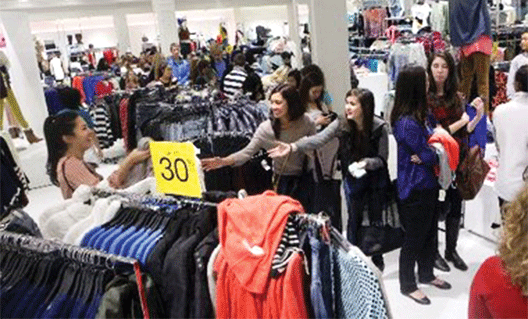The Hidden Environmental Impacts of the Fashion Industry

Few shoppers consider sustainability when purchasing new clothing, but surprisingly the fashion industry has a major environmental impact. From production to transport to disposal, the fashion industry is the third most polluting industry after oil and agriculture.
The impact of clothing begins with the production of fabric materials. Growing natural fibers is incredibly resource-intensive, with cotton alone responsible for a quarter of the pesticides used in the United States. Textile dyeing, which is responsible for 20 percent of industrial water pollution, also adds to the industry’s environmental impact. Factory-made clothing is extremely inefficient in its fabric usage. For each garment produced, 15 to 20 percent of the fabric is thrown away as scraps. With one billion garments coming out of China alone each year, that’s a lot of wasted material.
With the growth of fast fashion and cheap clothing retailers like Forever 21 and H&M, society has begun to see clothing as disposable. New wardrobes can be easily bought to follow changing trends and torn clothing can be discarded instead of repaired and worn again. The growth of this disposable mindset of fashion has lead to a major increase of perfectly good clothing in landfills. In fact, the average American throws away 68 pounds of unwanted clothing each year. Currently only 15 pounds of discarded clothing in the United States is sold in thrift and consignment shops. As clothing becomes cheaper to buy new, the perceived resale value of unwanted clothes has decreased considerably. Cheap clothing also removes the need to buy used clothing at discounted prices. Only 12 to 15 percent of Americans shop at resale shops, creating a major gap in the circle of recycling.
Many clothing companies have acknowledged the environmental impacts of the fashion industry and have begun working towards more sustainable practices. Sustainably harvested fibers, waterless dye processes and zero-waste manufacturing are all being tested out by various clothing brands. Consumer involvement is also a vital step in decreasing the environmental impact of the fashion industry. A movement away from the disposable mindset of clothing will help address the massive amount of waste created by discarded clothing. Quality of materials and construction should be highly valued and clothing should be seen as an investment. Higher quality garments will last much longer before fading or ripping. Consumers will also be more likely to repair a piece of clothing if they see it as a quality investment.
When a piece of clothing is discarded there are many ways to keep it out of a landfill. If the clothing is too worn or stained to be worn again it can be taken to a textile recycling center where it will be made into new fabric. If the clothing is still wearable, it can be donated to thrift stores (like Goodwill) or resold at consignment shops or through online retailers. In order to complete the circle of recycling more shoppers need to purchase used clothing. Used clothing stores today are much more upscale than many people imagine. Chains like Second Time Around, which has stores in 12 states, and the online retailer Tradesy.com, specialize in reselling brand name clothing for a fraction of the original price. These new resale stores simplify the shopping experience by eliminating the need to sift through racks and racks of clothes to find quality pieces.
While sustainability may not be a major consideration when purchasing clothing, simple measures can be taken to decrease the impact our clothing choices have on the environment. Shoppers should consider sustainable brands and used clothing stores when making purchases. Many rips can be easily repaired at home or by a tailor, greatly extending the life of a piece of clothing. Finally, unwanted clothing should always be recycled, donated or resold to ensure that it stays out of landfills.






